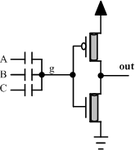kooheyakhi
Newbie level 4
Hello there,
I have designed a 3-input NAND gate by capacitor network connected to a NOT gate.
this circuit functions well. recently i have found out that when inputs are stable and a noise occurs in node g, functionality of my circuit fails. this is because of node g which is floating point of my circuit. given that inputs are logical "111" and supply voltage is 0.65v. in this case, voltage level of node g is 0.65v (can be proved by super position).
now if a spike or noise ocurs and leads to pull node g to ground, then this node never comes back to Vdd and will stay at 0v.
is there any one help me?? the structure of circuit is in the following
I have designed a 3-input NAND gate by capacitor network connected to a NOT gate.
this circuit functions well. recently i have found out that when inputs are stable and a noise occurs in node g, functionality of my circuit fails. this is because of node g which is floating point of my circuit. given that inputs are logical "111" and supply voltage is 0.65v. in this case, voltage level of node g is 0.65v (can be proved by super position).
now if a spike or noise ocurs and leads to pull node g to ground, then this node never comes back to Vdd and will stay at 0v.
is there any one help me?? the structure of circuit is in the following
